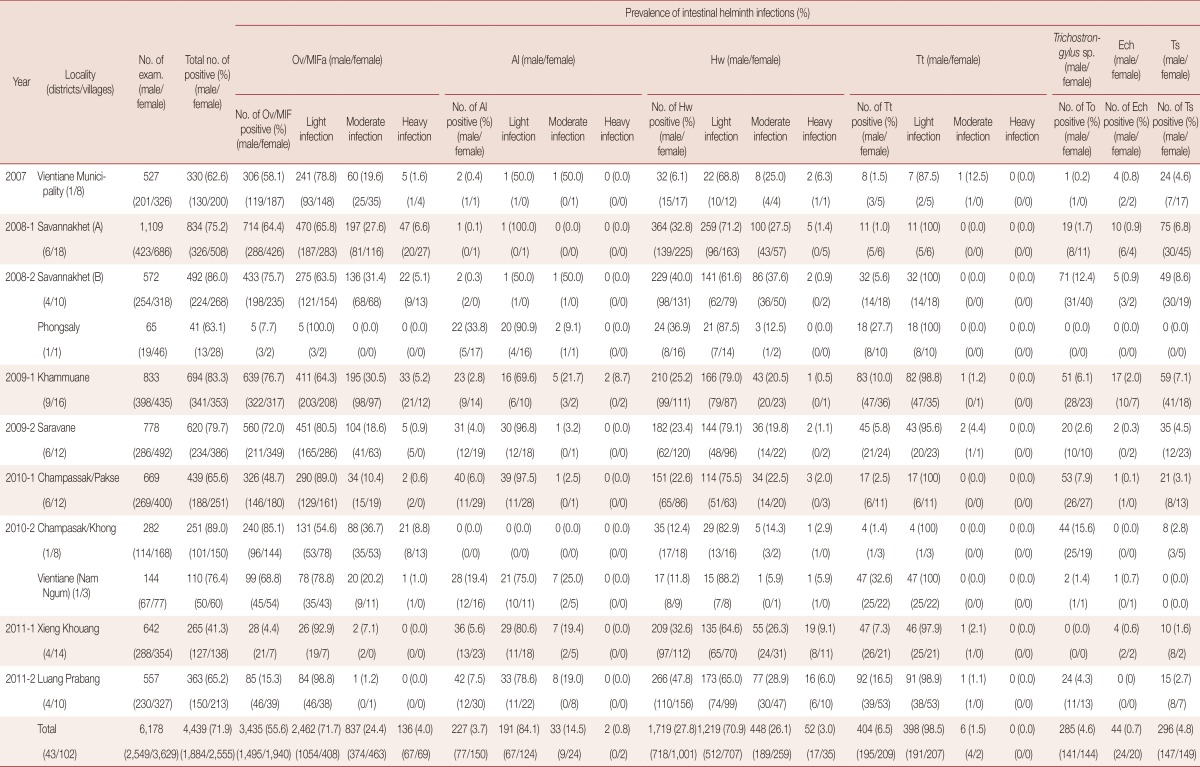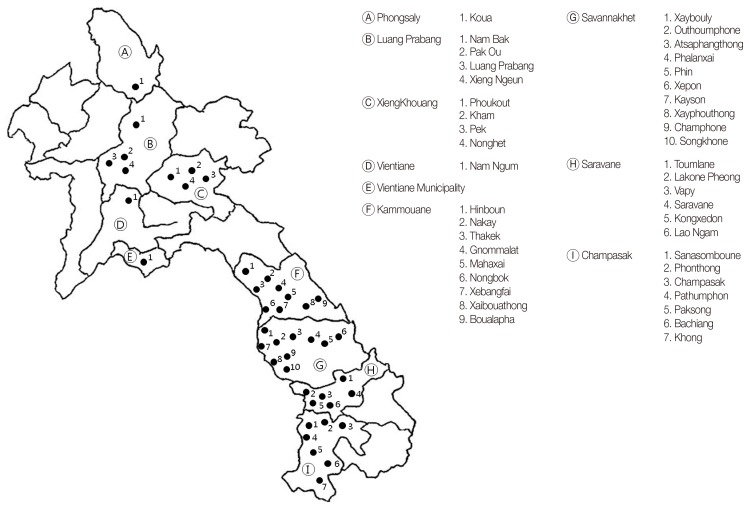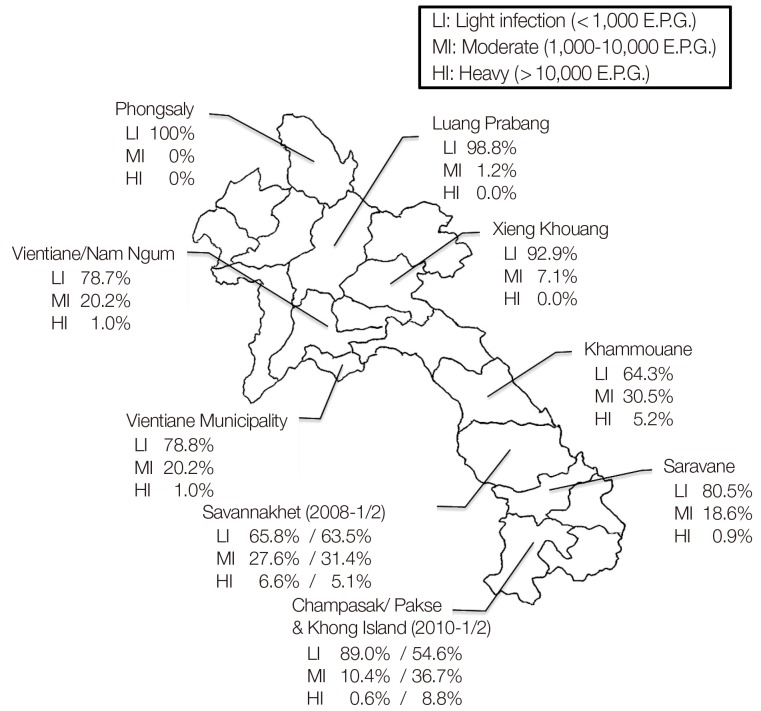Abstract
The prevalence of helminthic infections was surveyed on a total of 6,178 residents (males 2,549 and females 3,629) in 102 villages of 9 provinces in Lao PDR between 2007 and 2011 under the project of Korea-Laos Collaborative Project for Control of Foodborne Trematode Infections in Lao PDR. Fecal specimens were collected and examined by the Kato-Katz thick smear and Stoll's egg counting techniques. The overall liver/intestinal helminth egg positive rate was 71.9% with a single or mixed infections with Opisthorchis viverrini and minute intestinal flukes (Ov/MIF), Ascaris lumbricoides, hookworms, Trichuris trichiura, Trichostrongylus sp., echinostomes, Taenia spp., and others. Ov/MIF revealed the highest prevalence (55.6%) followed by hookworms (27.8%) and T. trichiura (6.5%). The endemic regions with the highest prevalence of Ov/MIF were Savannakhet, Khammouane, Vientiane (Nam Ngum), Champasak (Khong Island), and Saravane Province. High prevalences of A. lumbricoides (33.8%), hookworms (47.8%), and T. trichiura (32.6%) were observed in Phongsaly, Luang Prabang, and Vientiane (Nam Ngum) areas, respectively. The results of this study highlight helminth parasites of current public health significance in different areas of Lao PDR.
Keywords: Opisthorchis viverrini, foodborne trematode, intestinal helminth, liver fluke, minute intestinal fluke, Lao PDR
INTRODUCTION
Soil-transmitted helminths and foodborne trematodes are important human parasites in Lao People's Democratic Republic (Lao PDR) [1], and liver and intestinal flukes causing food-borne trematodiases are endemic in Lao PDR, Cambodia, Thailand, and Vietnam [2]. Previous studies have reported high prevalence of intestinal parasite infections among government staff and schoolchildren in different localities of Lao PDR. For example, the prevalence of intestinal helminths was 77.3% among schoolchildren below 15 years of age in Khammouane Province [3], 75.9% and 63.8% among government staff and schoolchildren in Champasak Province [4], 56.7% among children below 15 years of age in Bolikhamxay Province, and 81.9% in Khammouane Province [5,6]. In a nationwide survey of primary schoolchildren aged 6-11 conducted between 2000 and 2002, the overall prevalence of helminth infections was 61.9% [1]. The intestinal helminth eggs/larvae observed in previous studies included Ascaris lumbricoides, hookworms, Trichuris trichiura, Strongyloides stercoralis, Opisthorchis viverrini, Taenia sp., and Hymenolepis spp.
Studies from neighboring countries along the Mekong river basin, in particular Thailand, Cambodia, and Vietnam, have reported high prevalences of fish-borne parasites. In previous studies on Lao PDR, the prevalence of fish-borne helminth infections detected by stool examination was 67.1% and 81.1% in Savannakhet and Kammouane Province, respectively [7,8]. Worm receovery revealed mixed infections with various helminths, including hookworms, T. trichiura, A. lumbricoides, Enterobius vermicularis, Trichostrongylus spp., Taenia saginata, echinostomes, O. viverrini, Haplorchis taichui, Haplorchis pumilio, Haplorchis yokogawai, Prosthodendrium molenkampi, and Pha neropsolus bonnei [7,8].
Helminthic infections are one of the neglected zoonotic diseases typically affecting rural communities in the developing world. Foodborne liver flukes, including O. viverrini, Opisthorchis felineus, and Clonorchis sinensis, cause morbidity and mortality in people and can cause a serious socioeconomic impact [2]. Due to the strong tradition of the Laotian people eating raw freshwater fish, exposure to liver flukes in Lao PDR is high, particularly for those residing in the Mekong river basin.
The aim of the present study was to undertake a parasitological survey to elucidate the diversity and prevalence of helminthic infections in Lao PDR and to identify species of current public health significance.
MATERIALS AND METHODS
Areas and populations surveyed
A total of 6,178 fecal specimens, 1 sample from each person, were collected from residents (males 2,549 and females 3,629) of 102 villages in 43 districts within 9 provinces of Lao PDR, between the years 2007 and 2011. Surveys were conducted in Vientiane Municipality (n=527) in December 2007, Savannakhet (n=1,109) Province in June 2008, Savannakhet (n=572) and Phongsaly (n=65) Province in December 2008, Khammouane Province (n=833) in June 2009, Saravane Province (n=778) in December 2009, Champasak Province (n=669) in June 2010, Champasak (Khong Island) (n=282) and Vientiane/Nam Ngum Dam (n=144) in December 2010, Xieng Khouang (n=642) in June 2011, and Luang Prabang (n=557) in December 2011 (Fig. 1).
Fig. 1.
Surveyed areas in 8 provinces in Lao PDR. Provinces (A-R) and districts (numbers) are shown.
Fecal examinations
Fecal specimens were examined for intestinal helminth eggs using the Kato-Katz smear technique or Stoll's dilution egg counting method. Eggs of O. viverrini and minute intestinal flukes (MIF) that could not be differentiated only by morphology were recorded collectively as Ov/MIF.
RESULTS
The overall helminth egg positive rate was 71.8% (4,439/6,178) (Table 1). The most frequently encountered was O. viverrini and MIF (Ov/MIF), with an egg positive rate of 55.6%. Eggs of other parasites included A. lumbricoides (3.7%), hookworms (27.8%), T. trichiura (6.5%), Trichostrongylus sp. (4.6%), Taenia spp. (4.8%), and echinostomes (0.7%) (Table 1). Eggs of other helminths, e.g., E. vermicularis and Schistosoma mekongi were also observed in a few cases. Although the most frequently encountered eggs in the study were those of Ov/MIF (55.6%), 3 localities had higher prevalences of other intestinal helminths, e.g., A. lumbricoides (33.8%) in Phongsaly, hookworms (47.8%) in Luang Prabang, T. trichiura (32.6%) in Vientiane/Nam Ngum. S. mekongi eggs were found only in Champasak/Khong Island region (Table 1). The Ov/MIF endemic regions with the highest prevalence were those located in the Mekong river basin, e.g., Savannakhet (64.4-75.7%), Khammouane (76.7%), Vientiane/Nam Ngum (68.8%), Champasak/Pakse (48.7-85.1%) and Saravane Province (72.0%). Among them, Champasak/Pakse and Saravane Province turned out to be mixed endemic regions of MIF and O. viverrini.
Table 1.
Prevalence and intensity of intestinal helminth infections in 9 provinces of Lao PDR (2007-2011)

aOv/MIF: Opisthorchis viverrini/minute intestinal flukes (mostly Haplorchis taichui), Al: Ascaris lumbricoides, Hw: hookworms, Tt: Trichuris trichiura, Ech: Echinostome, Ts: Taenia spp.
Overall light (<1,000 epg), moderate (1,000-10,000), and heavy (>10,000 epg) infections of O. viverrini and MIF shared 71.7%, 24.4%, and 4.0%, respectively (Table 1). Heavy infections of Ov/MIF were noticed in several provinces such as Savannakhet (6.6%), Khammouane (5.2%), and Champasak/Khong (8.8%) (Fig. 2). High prevalences of soil-transmitted helminths were also recorded, although most cases were detected with light infections. Light (<5,000 epg), moderate (5,000-50,000 epg), and heavy (>50,000 epg) infections of A. lumbricoides were 84.1%, 14.5%, and 0.8%, respectively. Light (<400 epg), moderate (<3,000 epg) and heavy (>3,000 epg) infection of hookworms were 70.9%, 26.1%, and 3.0%, respectively. Light (<1,000 epg), moderate (1,000-10,000 epg) and heavy (>10,000 epg) infections of T. trichiura were 98.5%, 1.5%, and 0%, respectively (Table 1).
Fig. 2.
Map showing the prevalence and intensity of Opisthorchis viverrini and minute intestinal flukes in Lao PDR.
DISCUSSION
The overall prevalence (71.9%) of helminth infections in this survey was somewhat higher than that (61.9%) reported in a previous study in various localities of Lao PDR in 2000-2002 [1]. The remarkable difference in the 2 surveys was much higher prevalence of Ov/MIF eggs in this survey and much decreased prevalence of soil-transmitted helminths, in particular, A. lumbricoides and T. trichiura, in this survey [1].
In 2000-2002, the prevalence of A. lumbricoides infection was very high in Phongsaly (81.9%), Saysamboune (73.4%), and Huaphan (72.0%), and averaged 34.9% nationwidely. However, in the present study, the prevalence of A. lumbricoides became much decreased, with the average prevalence becoming only 3.6%. The highest prevalence was found in Phongsaly (33.8%) and Vientiane (Nam Ngum) Province (19.3%). Though not comparable with A. lumbricoides, the prevalence of T. trichiura also showed a remarkable decrease. The average prevalence in 2000-2002 was 25.8% [1] but it was reduced to 6.5% in 2007-2011 (this study).
However, with regard to hookworm infections, the average prevalence in 2000-2002 was 19.1% but that in this study was 27.8%, a somewhat increased figure. In particular, the hookworm prevalence remained over 30% in 4 provinces including Luang Prabang, Xieng Khouang, Phongsaly, and Savannakhet Province. This represents no decrease in the hookworm prevalence in many localities of Lao PDR during the past 7-9 years.
The prevalence of Ov/MIF in 2000-2002 was 10.9% [1]. However, in this study, Ov/MIF infection was found to be 55.6%, almost 5-fold higher than the figure of 7-9 years before. This can be explained that the present survey was performed mainly in known endemic areas of foodborne helminths such as Ov/MIF, whereas the previous survey was performed just nationwidely. It is of note that, by worm recovery studies, Saravane and Champasak Province was verified to be an endemic area of MIF (e.g., Haplorchis taichui) only with a low grade O. viverrini infection [9]. Agreeing to a previous study [7], the high prevalence (64.4-75.6%) of Ov/MIF in Savannakhet Province, was confirmed mainly due to O. viverrini infection by worm recovery from egg positive cases (to be published). The results of worm recovery in other provinces (Luang Prabang, Xieng Khouang, Khong Island, and Nam Ngum Dam areas) will also be reported separately.
Regarding Taenia tapeworm infections in Lao PDR, a total of 845 egg positive cases (including the present 296 egg positive cases) and 126 adult Taenia specimens recovered from Laotian people in 17 provinces during 2000-2011 were analyzed [10]. The results revealed that the average prevalence of Taenia eggs was 1.5% (845/55,038) by the Kato-Katz technique [10]. Molecular analysis of the adult specimens using mitochondrial cytochrome c oxidase 1 (cox1) sequencing (440 bp) revealed that 3 of 126 specimens showed 99% similarity with Taenia solium, and the remaining 123 samples showed 99% similarity with Taenia saginata [10]. So far, no Taenia asiatica infections were found in Lao PDR.
In this study, most of the egg positive patients had mixed-infections with several kinds of intestinal helminth species, including heterophyids, lecitodendriids, and O. viverrini. The opisthorchiid liver flukes and heterophyid intestinal flukes are highly prevalent in endemic areas of southeast Asia, and Taenia spp. are also endemic in this region. Discrimination of these parasites in endemic regions based on egg morphology alone is difficult due to their morphological similarity. Over the past decade, the egg shell morphology has been used to distinguish the eggs of haplorchiid and opisthorchiid flukes [11]; however, it does not enable differentiation at a species level. More recently, PCR assays have been developed to improve the specificity and sensitivity of discriminating between O. viverrini and MIF species and cestodes also [12-14].
O. viverrini infection is known to be a major risk factor for cholangiocarcinoma. In Lao PDR, an estimated 2.5 million individuals are infected with O. viverrini [15]. A recent report suggested that O. viverrini infects 10 million people in Lao PDR and Thailand together [16]. The present study indicates that opisthorchiasis is highly endemic in Lao PDR, particularly in central and lowland areas, such as Vientiane, Khammouane, Savannakhet, and Khong Island. However, there were no well-organized control measures against opisthorchiasis in Lao PDR, and the incidence of cholangiocarcinoma in each endemic area has not been precisely known. To elucidate this and to establish strategies for prevention and control, determination of the relative predominance of O. viverrini and MIF in each specific endemic area is an important prerequisite.
ACKNOWLEDGMENTS
We thank Korea Foundation for International Healthcare (KOFIH), KOICA, and Ministry of Healthcare of Lao PDR that have backed a collaborative project of Korea-Lao PDR Collaborative Project for Control of Foodborne Trematode Infections (2007-2011). This work was supported by a research grant from Chungbuk National University in 2011 for tapeworm DNA analysis, data processing, and statistical analysis. Some parasite materials used in this study were provided by the Parasite Resource Bank of Korea, National Research Center (2012-0000037), Republic of Korea.
Footnotes
We declare no conflict of interest related with this work.
References
- 1.Rim HJ, Chai JY, Min DY, Cho SY, Eom KS, Hong SJ, Sohn WM, Yong TS, Standgaard GDH, Phommasack B, Yun CH, Hoang EH. Prevalence of intestinal parasite infections on a national scale among primary schoolchildren in Laos. Parasitol Res. 2003;91:267–272. doi: 10.1007/s00436-003-0963-x. [DOI] [PubMed] [Google Scholar]
- 2.Chai JY, Murrell KD, Lymbery AJ. Fishborne parasitic zooneses: status and issues. Int J Parasitol. 2005;35:1233–1254. doi: 10.1016/j.ijpara.2005.07.013. [DOI] [PubMed] [Google Scholar]
- 3.Kobayashi J, Vannachone B, Xeutvongsa A, Manivang K, Ogawa S, Sato Y, Pholsena K. Prevalence of intestinal parasitic infection among children in two villages in Lao PDR. Southeast Asian J Trop Med Public Health. 1996;27:562–565. [PubMed] [Google Scholar]
- 4.Chai JY, Hongvanthong B. A small-scale survey of intestinal helminthic infections among the residents near Parkse, Laos. Korean J Parasitol. 1998;36:55–58. doi: 10.3347/kjp.1998.36.1.55. [DOI] [PubMed] [Google Scholar]
- 5.Hohmann H, Panzer S, Phimpachan C, Southivong C, Schelp PF. Relationship of intestinal parasites to the environment and to behavioral factors in children in the Bolikhamxay province of Lao PDR. Southeast Asian J Trop Med Public Health. 2001;32:4–13. [PubMed] [Google Scholar]
- 6.Vannachone B, Kobayashi J, Nambany S, Manivong K, Inthakone S, Sato Y. Epidemiological survey on intestinal parasite infection in Khammouane province, Lao PDR, with special reference to Strongyloides infection. Southeast Asian J Trop Med Public Health. 1998;29:717–722. [PubMed] [Google Scholar]
- 7.Chai JY, Han ET, Guk SM, Shin EH, Sohn WM, Yong TS, Eom KS, Lee KH, Jeong HG, Ryang YS, Hoang EH, Phommasack B, Insisiengmay B, Lee SH, Rim HJ. High prevalence of liver and intestinal fluke infections among residents of Savannakhet Province in Laos. Korean J Parasitol. 2007;45:213–218. doi: 10.3347/kjp.2007.45.3.213. [DOI] [PMC free article] [PubMed] [Google Scholar]
- 8.Chai JY, Han ET, Shin EH, Sohn WM, Yong TS, Eom KS, Min DY, Um JY, Park MS, Hoang EH, Phommasack B, Insisiengmay B, Lee SH. High prevalence of Haplorchis taichui, Prosthodendrium melenkampi, and other helminth infections among people in Khammouane province, LaoPDR. Korean J Parasitol. 2009;47:243–247. doi: 10.3347/kjp.2009.47.3.243. [DOI] [PMC free article] [PubMed] [Google Scholar]
- 9.Chai JY, Yong TS, Eom KS, Min DY, Jeon HK, Kim TY, Jung BK, Sisabath L, Insisiengmay B, Phommasack B, Rim HJ. Hyperendemicity of Haplorchis taichui infection among riparian people in Saravane and Champasak Province, Lao PDR. Korean J Parasitol. 2013;51:305–311. doi: 10.3347/kjp.2013.51.3.305. [DOI] [PMC free article] [PubMed] [Google Scholar]
- 10.Jeon HK, Yong TS, Sohn WM, Chai JY, Min DY, Yun CH, Rim HJ, Pongvongsa T, Banouvong V, Insisiengmay B, Phommasak B, Eom KS. Current status of human taeniasis in Lao Peoples' Democratic republic. Korean J Parasitol. 2013;51:259–263. doi: 10.3347/kjp.2013.51.2.259. [DOI] [PMC free article] [PubMed] [Google Scholar]
- 11.Ditrich O, Giboda M, Sterba J. Species discrimination of eggs of opisthorchiid and heterophyid flukes using scanning electron microscopy. Angew Parasitol. 1990;31:3–9. [PubMed] [Google Scholar]
- 12.Le TH, De NV, Blair D, Sithithaworn P, McManus DP. Clonorchis sinensis and Opisthorchis viverrini: development of a mitochondrial-based multiplex PCR for their identification and discrimination. Exp Parasitol. 2006;112:109–114. doi: 10.1016/j.exppara.2005.09.012. [DOI] [PubMed] [Google Scholar]
- 13.Parvathi A, Kumar HS, Prakasha BK, Lu J, Xu X, Hu W, Feng Z, Karunasagar I. Clonorchis sinensis: development and evolution of a nested polymerase chain reaction (PCR) assay. Exp Parasitol. 2007;115:291–295. doi: 10.1016/j.exppara.2006.09.010. [DOI] [PubMed] [Google Scholar]
- 14.Thaenkham U, Visetsuk K, Dung DT, Waikagul J. Discrimination of Opisthorchis viverrini from Haplorchis taichui using COI sequence marker. Acta Trop. 2007;103:26–32. doi: 10.1016/j.actatropica.2007.05.006. [DOI] [PubMed] [Google Scholar]
- 15.Fürst T, Keiser J, Utzinger J. Global burden of human food-borne trematodiasis: a systematic review and meta-analysis. Lancet Infect Dis. 2012;12:210–221. doi: 10.1016/S1473-3099(11)70294-8. [DOI] [PubMed] [Google Scholar]
- 16.Sripa B, Kaewkes, Intapan PM, Maleewong W, Brindly PJ. Food-borne trematodiasis in Southeast Asia: epidemiology, pathology, clinical manifestation and control. Adv Parasitol. 2010;72:305–350. doi: 10.1016/S0065-308X(10)72011-X. [DOI] [PubMed] [Google Scholar]




